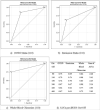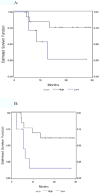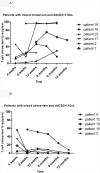Favorable outcomes in patients with high donor-derived T cell count after in vivo T cell-depleted reduced-intensity allogeneic stem cell transplantation
- PMID: 22005648
- PMCID: PMC4932864
- DOI: 10.1016/j.bbmt.2011.10.011
Favorable outcomes in patients with high donor-derived T cell count after in vivo T cell-depleted reduced-intensity allogeneic stem cell transplantation
Abstract
Patients with hematologic malignancies were conditioned using a rabbit antithymocyte globulin-based reduced-intensity conditioning regimen for allogeneic stem cell transplantation. Donor-derived CD3(+) cell count (ddCD3), a product of CD3(+) cell chimerism and absolute CD3(+) cell count, when <110/μL at 8 weeks post-stem cell transplantation predicted a high risk of sustained mixed chimerism and relapse. Alternatively, patients with a higher ddCD3 developed graft-versus-host disease more frequently, and when partially chimeric, had higher rates of conversion to full donor chimerism after withdrawal of immunosuppression. Early data from our small cohort of patients indicate that ddCD3 at 8 weeks may be used to guide decisions regarding withdrawal of immunosuppression and administration of donor lymphocyte infusion in partially T cell-depleted reduced-intensity regimens.
Published by Elsevier Inc.
Figures






References
-
- Dey BR, McAfee S, Sackstein R, et al. Successful allogeneic stem cell transplantation with nonmyeloablative conditioning in patients with relapsed hematologic malignancy following autologous stem cell transplantation. Biol Blood Marrow Transplant. 2001;7:604–612. - PubMed
-
- Remberger M, Storer B, Ringden O, Anasetti C. Association between pretransplant Thymoglobulin and reduced non-relapse mortality rate after marrow transplantation from unrelated donors. Bone Marrow Transplant. 2002;29:391–397. - PubMed
-
- Rodriguez-Luaces M, Ferra C, Martin-Henao G, Berlanga JJ, Granena A, Gallardo D. Mixed chimerism is frequent after allogeneic peripheral blood stem cell transplantation with positive CD34 selection, and is not reverted by low doses of donor T-cells add-back. Eur J Haematol. 2004;73:162–168. - PubMed
-
- Juliusson G, Theorin N, Karlsson K, Frodin U, Malm C. Subcutaneous alemtuzumab vs ATG in adjusted conditioning for allogeneic transplantation: influence of Campath dose on lymphoid recovery, mixed chimerism and survival. Bone Marrow Transplant. 2006;37:503–510. - PubMed
Publication types
MeSH terms
Substances
Grants and funding
LinkOut - more resources
Full Text Sources

